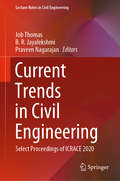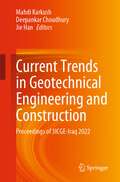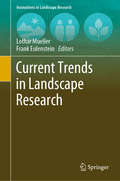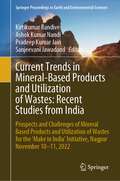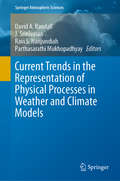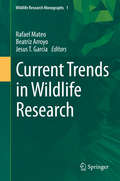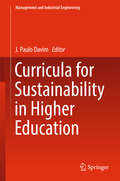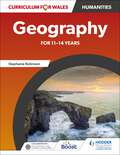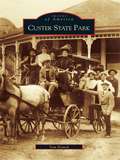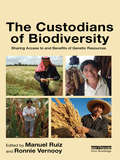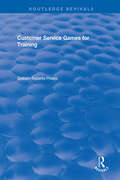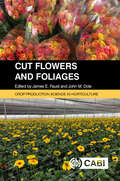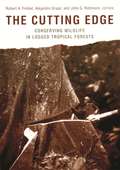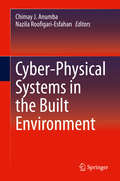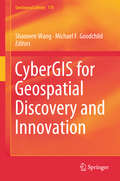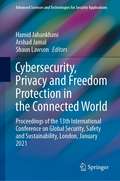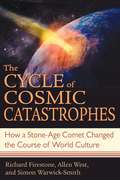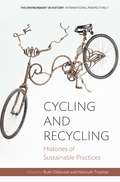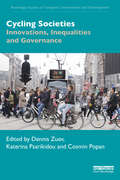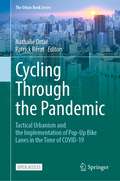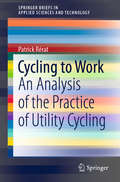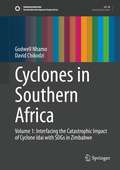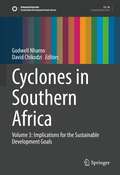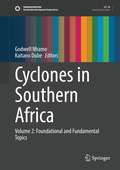- Table View
- List View
Current Trends in Civil Engineering: Select Proceedings of ICRACE 2020 (Lecture Notes in Civil Engineering #104)
by Job Thomas B. R. Jayalekshmi Praveen NagarajanThis book comprises the select proceedings of the International Conference on Recent Advances in Civil Engineering (ICRACE) 2020, held at the Cochin University of Science and Technology, Cochin, Kerala, India. The book focuses on latest research in different areas of civil engineering and lays special emphasis on sustainable construction practices. It is divided into seven major themes: (i) Modern materials and sustainable construction, (ii) Environmental engineering and management, (iii) Geotechnical engineering, (iv) Health, safety and environment, (v) Irrigation, water resources and management, (vi) Structural Engineering, and (vii) Transportation engineering and traffic planning. Given the range of the topics covered, this book can be useful for students, scholars and professionals interested in the different sub-disciplines of civil engineering.
Current Trends in Geotechnical Engineering and Construction: Proceedings of 3ICGE-Iraq 2022
by Mahdi Karkush Deepankar Choudhury Jie HanThis book contains selected articles from the third International Conference on Geotechnical Engineering-Iraq 2022 (3ICGE-2022) held on May 29–31, 2022, at the University of Baghdad/Baghdad/Iraq. This proceeding discusses the latest research and studies in geotechnical engineering and all related topics in different fields such as civil engineering, environmental engineering, and architectural engineering. This book gives participants from both academics and industry a great chance to learn about recent developments in Geotechnical engineering fields.
Current Trends in Landscape Research (Innovations in Landscape Research)
by Lothar Mueller Frank EulensteinThis book presents definitions, key concepts and projects in landscape research and related areas, such as landscape science and landscape ecology, addressing and characterising the international role, status, challenges, future and tools of landscape research in the globalised world of the 21st century. The book brings together views on landscapes from leading international teams and emerging authors from different scientific disciplines and regions of the globe. It describes approaches for achieving sustainability and for handling the multifunctionality of landscapes and includes international case studies demonstrating the great potential of landscape research to provide partial sustainable solutions while developing cultural landscapes and protecting semi-natural landscapes. It is intended for scientists from various disciplines as well as informed readers dealing with landscape policies, planning, evolvement, management, stewardship and conservation.
Current Trends in Mineral-Based Products and Utilization of Wastes: Prospects and Challenges of Mineral Based Products and Utilization of Wastes for the ‘Make in India’ Initiative, Nagpur November 10–11, 2022 (Springer Proceedings in Earth and Environmental Sciences)
by Kirtikumar Randive Ashok Kumar Nandi Pradeep Kumar Jain Sanjeevani JawadandMinerals are essential commodities for the growth of mankind, and all the progress of humanity owes unequivocally to minerals. However, winning minerals through mining has always been cursed, and mankind has paid a heavy price for mining in the form of great loss of flora and fauna and unprecedented impact on the environment. Notwithstanding any arguments either in favor or against, one cannot deny that for the progression, advancement, and security of nations mining is indispensable, compulsory, and unavoidable trade. It is in the best interest of every stakeholder; a sustainable approach to mining must be adopted. Sustainability has many dimensions, two most important being: the optimum utilization of mined-out materials and creating value-added products from the mining wastes. Taking a cue from this, an international seminar was organized on “Prospects and Challenges of Mineral Based Products and Utilization of Wastes for the ‘Make in India’ Initiative” at Hotel Radisson Blu from 10–12 November 2022. The conference was attended by about 120 delegates from all over India. This book is a compilation of selected papers presented during the conference, broadly divided into the following groups: (a) rare earth elements, (b) ferrous minerals, (c) non-ferrous minerals, (d) industrial minerals, (e) waste utilization and valorization and (f) other significant contributions. Written by experts and edited by academicians and technocrats, this book promises to be a valuable and essential reading for professionals, researchers, as well as students.
Current Trends in the Representation of Physical Processes in Weather and Climate Models (Springer Atmospheric Sciences)
by David A. Randall J. Srinivasan Ravi S. Nanjundiah Parthasarathi MukhopadhyayThis book focuses on the development of physical parameterization over the last 2 to 3 decades and provides a roadmap for its future development. It covers important physical processes: convection, clouds, radiation, land-surface, and the orographic effect. The improvement of numerical models for predicting weather and climate at a variety of places and times has progressed globally. However, there are still several challenging areas, which need to be addressed with a better understanding of physical processes based on observations, and to subsequently be taken into account by means of improved parameterization. And this is all the more important since models are increasingly being used at higher horizontal and vertical resolutions. Encouraging debate on the cloud-resolving approach or the hybrid approach with parameterized convection and grid-scale cloud microphysics and its impact on models’ intrinsic predictability, the book offers a motivating reference guide for all researchers whose work involves physical parameterization problems and numerical models.
Current Trends in Wildlife Research (Wildlife Research Monographs #1)
by Rafael Mateo Beatriz Arroyo Jesus T. GarciaThis book, the first in the "WildlifeResearch Monograph" series, defines "wildlife research" in a variety ofcontexts and reviews recent research trends. The authors present the currentdevelopments they have identified using bibliometric analyses of the mostcommon, relevant and emerging topics in wildlife research over the last three decades. Diverse aspects of wildlife research are discussed, including wildlifedemography, infections spread between wildlife, livestock and humans, habitatrequirements and management, as well as the effects of renewable energy andpollutants on wildlife. Furthermore the authors explore topics like advances inthe study of species distribution, invasive species, use of molecular markersin wildlife studies and the sustainability of wildlife exploitation andconservation conflicts. The book offers a comprehensive overview of advances inwildlife research in the last decades.
Curricula for Sustainability in Higher Education (Management and Industrial Engineering)
by J. Paulo DavimThis books presents the curricula necessary for sustainability in higher education. It shows how the learning process is transforming in order to promote sustainability. It prepares administrators, teachers and students to diffuse the development in the field, showing a curricula based on three interconnected pillars: the environment, the economic and the social aspects. It contains 8 chapters introducing research advances in the field.
Curriculum for Wales: Geography for 11–14 years
by Stephanie Robinson Jo Coles David Gardner John Lyon Catherine OwenEmbodying the aims of the new curriculum for Wales, and forming part of the Humanities Area of Learning and Experience, Curriculum for Wales: Geography for 11-14 years will help you plan your curriculum, offering 18 chapters packed full of geographical resources, including maps, charts, diagrams and data.>> Build students' curiosity about the world around them - how it developed, what it is like now, and what it could be like in the future by helping you develop an enquiry-based approach to learning.>> Explore geography at a local, national and global scale and foster students' sense of cynefin with a focus on Wales and its place on the wider world.>> Develop core geographical skills with fieldwork enquiries embedded into the context of topics, encouraging students to investigate their local area.>> Support teachers in planning and assessment with suggested learning objectives.>> Help students to consider topics in the context of their own lives and the local area in which they live with regular 'My place' activities.>> Encourage students to think about the impact of human actions in their local area, on Wales and the world, to develop ethical informed citizens.>> Choose from crucial content areas including: weather and climate; ecosystems; landscapes and national parks; rural and urban places; sport and culture; climate change; disease; global consumers and more.
Curvilinear Micromagnetism: From Fundamentals to Applications (Topics in Applied Physics #146)
by Denys Makarov Denis D. ShekaThis is the first book providing overview of magnetism in curved geometries, highlighting numerous peculiarities emerging from geometrically curved magnetic objects such as curved wires, shells, as well as complex three-dimensional structures. Extending planar two-dimensional structures into the three-dimensional space has become a general trend in multiple disciplines across electronics, photonics, plasmonics and magnetics. This approach provides the means to modify conventional and even launch novel functionalities by tailoring the local curvature of an object. The book covers the theory of curvilinear micromagnetism as well as experimental studies of geometrically curved magnets including both fabrication and characterization. With its coverage of fundamental aspects, together with exploration of numerous applications across magnonics, bio-engineering, soft robotics and shapeable magnetoelectronics, this edited collection is ideal for all scientists in academia and industry seeking an overview and wishing to keep abreast of advances in the novel field of curvilinear micromagnetism. It provides easy but comprehensive access to the field for newcomers, and can be used for graduate-level courses on this subject.
Custer State Park
by Tom DomekCuster State Park is one of the largest and most beautiful state parks in the nation. From towering granite spires and pine-draped mountains to trout streams and remote savanna, the park offers scenic wonders and recreational opportunities seldom matched on the Northern Great Plains. First established as a state forest in 1912, today the park is home to one of the largest bison herds in the country, as well as other rare flora and fauna. Prior to settlement, the Black Hills were Lakota territory. After gold was discovered along French Creek in 1874, the government waged war on the Lakota, forcing them onto reservations, and settlers rushed to the region. Photos and narrative in this book provide an intriguing overview of the park's rich natural and social history. Whether the subject is Cathedral Spires or Sylvan Lake, General George Custer or Black Elk, Custer State Park will engage those who value history and the last few unspoiled places left in the country.
The Custodians of Biodiversity: Sharing Access to and Benefits of Genetic Resources
by Ronnie Vernooy Manuel RuizGlobally, local and indigenous approaches to conserving biodiversity, crop improvement, and managing precious natural resources are under threat. Many communities have to deal with 'biopiracy,' for example. As well, existing laws are usually unsuitable for protecting indigenous and traditional knowledge and for recognizing collective rights, such as in cases of participatory plant breeding, where farmers, researchers and others join forces to improve existing crop varieties or develop new ones, based on shared knowledge and resources. This book addresses these issues. It outlines the national and international policy processes that are currently underway to protect local genetic resources and related traditional knowledge and the challenges these initiatives have faced. In particular these themes are addressed within the context of the Convention of Biological Diversity and the International Treaty on Plant Genetic Resources for Food and Agriculture. The authors broaden the policy and legal debates beyond the sphere of policy experts to include the knowledge-holders themselves. These are the 'custodians of biodiversity': farmers, herders and fishers in local communities. Their experience in sharing access and benefits to genetic resources is shown to be crucial for the development of effective national and international agreements. The book presents and analyzes this experience, including case studies from China, Cuba, Honduras, Jordan, Nepal, Peru and Syria. Copublished with the International Development Research Centre (IDRC).
Customer Service Games for Training (Routledge Revivals)
by Graham Roberts-PhelpsThis title was first published in 2011.After World War II, a systems approach to solving complex problems and managing complex systems came into vogue among engineers, scientists, and managers, fostered in part by the diffusion of digital computing power.Enthusiasm for the approach peaked during the Johnson administration, when it was applied to everything from military command and control systems to poverty in American cities. Although its failure in the social sphere, coupled with increasing skepticism about the role of technology and "experts" in American society, led to a retrenchment, systems methods are still part of modern managerial practice.
Cut Flowers and Foliages (Crop Production Science in Horticulture)
by Raul I Cabrera Elizabeth Cieniewicz Melissa Muñoz Henry WainwrightThe cut flower and foliage industry is a global business with major production locations in North America, South America, Central America, East Africa, Europe, the Middle East, Asia, Australia and New Zealand. Few other horticulture crops are as ubiquitous, yet the production techniques and challenges are universal. This book describes the main international production locations and markets, including current trends and directions. The focus is on production in protected cultivation. The major species - including rose, chrysanthemum, carnation, orchid and gerbera - dominate the global market and these are individually explored in detail. Specialty species and cut foliages are also addressed, as well as significant details of production, including irrigation and fertilization, disease and disease management, and biological control of pests. Finally, the postharvest chapter covers details of harvesting, transporting and delivering high quality flowers that provide an excellent vase life. Highly illustrated with color photos throughout, this is an essential resource for students and researchers in horticulture, growers and producers, and those in the floriculture industry.
The Cutting Edge: Conserving Wildlife in Logged Tropical Forests
by John G. Robinson Alejandro Grajal Robert A. FimbelBringing together leading scientists and professionals in tropical forest ecology and management, this book examines in detail the interplay between timber harvesting and wildlife, from invertebrates to large mammal species. Its contributors suggest modifications to existing practices that can ensure a better future for the tropics' valuable--and invaluable--resources.
Cyber-Physical Systems in the Built Environment
by Chimay J. Anumba Nazila Roofigari-EsfahanThis book introduces researchers and practitioners to Cyber-Physical Systems (CPS) and its applications in the built environment. It begins with a fundamental introduction to CPS technology and associated concepts.It then presents numerous examples of applications from managing construction projects to smart transportation systems and smart cities. It concludes with a discussion of future directions for CPS deployment in the construction, operation and maintenance of constructed facilities. Featuring internationally recognized experts as contributors, Cyber-Physical Systems in the Built Environment, is an ideal resource for engineers, construction managers, architects, facilities managers, and planners working on a range of building and civil infrastructure projects.
CyberGIS for Geospatial Discovery and Innovation (GeoJournal Library #118)
by Shaowen Wang Michael F. GoodchildThis book elucidates how cyberGIS (that is, new-generation geographic information science and systems (GIS) based on advanced computing and cyberinfrastructure) transforms computation- and data-intensive geospatial discovery and innovation. It comprehensively addresses opportunities and challenges, roadmaps for research and development, and major progress, trends, and impacts of cyberGIS in the era of big data. The book serves as an authoritative source of information to fill the void of introducing this exciting and growing field. By providing a set of representative applications and science drivers of cyberGIS, this book demonstrates how cyberGIS has been advanced to enable cutting-edge scientific research and innovative geospatial application development. Such cyberGIS advances are contextualized as diverse but interrelated science and technology frontiers. The book also emphasizes several important social dimensions of cyberGIS such as for empowering deliberative civic engagement and enabling collaborative problem solving through structured participation. In sum, this book will be a great resource to students, academics, and geospatial professionals for leaning cutting-edge cyberGIS, geospatial data science, high-performance computing, and related applications and sciences.
Cybersecurity, Privacy and Freedom Protection in the Connected World: Proceedings of the 13th International Conference on Global Security, Safety and Sustainability, London, January 2021 (Advanced Sciences and Technologies for Security Applications)
by Hamid Jahankhani Arshad Jamal Shaun LawsonThis book provides an opportunity for investigators, government officials, systems scientists, strategists, assurance researchers, owners, operators and maintainers of large, complex and advanced systems and infrastructures to update their knowledge with the state of best practice in the challenging domains whilst networking with the leading representatives, researchers and solution providers. Drawing on 12 years of successful events on information security, digital forensics and cyber-crime, the 13th ICGS3-20 conference aims to provide attendees with an information-packed agenda with representatives from across the industry and the globe. The challenges of complexity, rapid pace of change and risk/opportunity issues associated with modern products, systems, special events and infrastructures. In an era of unprecedented volatile, political and economic environment across the world, computer-based systems face ever more increasing challenges, disputes and responsibilities, and whilst the Internet has created a global platform for the exchange of ideas, goods and services, it has also created boundless opportunities for cyber-crime. As an increasing number of large organizations and individuals use the Internet and its satellite mobile technologies, they are increasingly vulnerable to cyber-crime threats. It is therefore paramount that the security industry raises its game to combat these threats. Whilst there is a huge adoption of technology and smart home devices, comparably, there is a rise of threat vector in the abuse of the technology in domestic violence inflicted through IoT too. All these are an issue of global importance as law enforcement agencies all over the world are struggling to cope.
The Cycle of Cosmic Catastrophes: How a Stone-Age Comet Changed the Course of World Culture
by Allen West Richard Firestone Simon Warwick-SmithNewly discovered scientific proof validating the legends and myths of ancient floods, fires, and weather extremes• Presents new scientific evidence revealing the cause of the end of the last ice age and the cycles of geological events and species extinctions that followed• Connects physical data to the dramatic earth changes recounted in oral traditions around the world • Describes the impending danger from a continuing cycle of catastrophes and extinctionsThere are a number of puzzling mysteries in the history of Earth that have yet to be satisfactorily explained by mainstream science: the extinction of the dinosaurs, the vanishing of ancient Indian tribes, the formation of the mysterious Carolina Bays, the disappearance of the mammoths, the sudden ending of the last Ice Age, and the cause of huge underwater landslides that sent massive tsunamis racing across the oceans millennia ago. Eyewitness accounts of these events are chronicled in rich oral traditions handed down through generations of native peoples. The authors’ recent scientific discoveries link all these events to a single cause.In The Cycle of Cosmic Catastrophes Richard Firestone, Allen West, and Simon Warwick-Smith present new scientific evidence about a series of prehistoric cosmic events that explains why the last Ice Age ended so abruptly. Their findings validate the ubiquitous legends and myths of floods, fires, and weather extremes passed down by our ancestors and show how these legendary events relate to each other. Their findings also support the idea that we are entering a thousand-year cycle of increasing danger and possibly a new cycle of extinctions.
Cycling and Recycling: Histories of Sustainable Practices (Environment in History: International Perspectives #7)
by Ruth Oldenziel Helmuth TrischlerTechnology has long been an essential consideration in public discussions of the environment, with the focus overwhelmingly on creating new tools and techniques. In more recent years, however, activists, researchers, and policymakers have increasingly turned to mobilizing older technologies in their pursuit of sustainability. In fascinating case studies ranging from the Early Modern secondhand trade to utopian visions of human-powered vehicles, the contributions gathered here explore the historical fortunes of two such technologies—bicycling and waste recycling—tracing their development over time and providing valuable context for the policy successes and failures of today.
Cycling Societies: Innovations, Inequalities and Governance (Routledge Studies in Transport, Environment and Development)
by Dennis Zuev; Katerina Psarikidou; Cosmin PopanThis book examines emerging debates and questions around cycling to critically analyse and challenge dominant framings and prevalent conventions of ‘good cycling’. Cycling Societies brings to light the plurality of voices and forms of cycling in other societies, revealing the diversity and complexity of cycling across different socio-political regimes, geographies and cultures. It presents case studies from five continents and demonstrates the need of thinking comparatively about cycling and urban environments. The book pivots around the three themes of innovations, inequalities and governance and engages a diversity of voices: world-renowned academics in the field of cycling and urban mobility, cycling activists and transportation consultants. Synthesising academic contributions with policy briefs, this innovative book will be of great interest to students, scholars and practitioners of sustainable transportation, urban planning and mobility studies.
Cycling Through the Pandemic: Tactical Urbanism and the Implementation of Pop-Up Bike Lanes in the Time of COVID-19 (The Urban Book Series)
by Nathalie Ortar Patrick RératThis open access book provides insight on how the tactical urbanism has the capacity to influence change in mobility practices such as cycling. COVID-19 crisis prompted the public authorities to rethink the use of public space in order to develop means of transport that are both efficient and adapted to the health context and their effects on cycling practices in Europe, North, and South America. Its contributors collectively reveal and evidence through policies analysis, mapping, and innovative qualitative analysis bridging video and interviews, how those new infrastructures and policies can be a trigger for change in a context of mobility transition.This book provides an important element on the way local authorities can act in a quicker and more agile way. While some decisions are specific to the context of the beginning of the pandemic, the analysis offers lessons on the way to implement the transition toward a low-carbon mobility, on the importance of processes based on trials and errors, on the political stakes of reallocating road space.
Cycling to Work: An Analysis of the Practice of Utility Cycling (SpringerBriefs in Applied Sciences and Technology)
by Patrick RératThis book presents a thorough discussion of utility cycling, cycling in the urban environment, and everyday mobility. It is based on large survey answered by 14,000 participants in the bike to work action in Switzerland, and quantifies the various dimensions of utility cycling.It proposes an innovative theoretical framework to analyse and understand the various dimensions of the uses of bikes and their diversity. It addresses the factors that motivate commuters to get on their bike, and highlights the barriers to this practice between deficient infrastructures and lack of legitimacy. This research makes a diagnosis and discusses the way to develop this sustainable mode of transportation. By combining quantitative results in the form of tables, figures, and maps, and including qualitative results in the form of quotations from survey participants, this book provides a thorough and enjoyable read. It will be of interest to researchers, policy makers, advanced students in the field of urban planning, social sciences, and transportation.
Cyclones in Southern Africa: Volume 1: Interfacing the Catastrophic Impact of Cyclone Idai with SDGs in Zimbabwe (Sustainable Development Goals Series)
by Godwell Nhamo David ChikodziThere is evidence that the world has been witnessing more intense tropical cyclones. Accompanying these tropical cyclones are heightened levels of devastation that witness the loss of human life and wildlife, destruction of natural resources and property and the disruption of major economic and social activities. To this end, there is a growing demand for publications focusing on tropical cyclones at various levels that include regional, national and local levels, especially from Africa. One sub-region that has been witnessing the harsh realities of the increasing intensity of tropical cyclones in southern Africa. However, within this region, countries are usually impacted at varying degrees of damage. Among the countries that usually encounter the harshness of these tropical cyclones are the Comoros, Botswana, Madagascar, Mauritius, Malawi, Mozambique, Reunion, the Seychelles, South Africa and Zimbabwe. From the history books, the following tropical cyclones made landfall and hit southern Africa: Eline (2000), Favio (2007), Dineo (2017), Idai (2019), Kenneth (2019), Eliose (2021), and Chalane (2020). Although all these tropical cyclones had negative impacts, it is undoubtedly Tropical Cyclone Idai that shocked the world with its devastation mainly in Mozambique, Malawi and Zimbabwe in March 2019. Key infrastructure was destroyed, livelihoods were lost, and the environment was degraded. Thousands of people died, many more were injured, many remain unaccounted for and others remained homeless as of the time of finalising this book in February 2021. This book, therefore focuses on the devastating impacts of Tropical Cyclone Idai in Zimbabwe. The book interfaces Tropical Cyclone Idai’s impacts with the 2030 Agenda for Sustainable Development and some of the 17 Sustainable Development Goals (SDGs). This linkage was deliberate given that there is still time remaining until 2030, and the world has generally agreed to move into the future along the pathways of sustainable development and sustainability. The book adds to the first comprehensive profiling of the impacts of tropical cyclones on southern African economies, particularly that of Zimbabwe. It also comes up as the first in a three-volume series. The other volumes to look out for are Cyclones in Southern Africa Vol 2: Foundational and Fundamental Topics; and Cyclones in Southern Africa Vol 3: Implications for the Sustainable Development Goals. To this end, this book is suitable as a read for several professionals and disciplines such as tourism and hospitality studies, economics, sustainable development, development studies, environmental sciences, arts, geography, life sciences, politics, planning and public health.
Cyclones in Southern Africa: Volume 3: Implications for the Sustainable Development Goals (Sustainable Development Goals Series)
by Godwell Nhamo David ChikodziTropical cyclones in Southern Africa, also known as hurricanes or typhoons in other regions of the world, is a hot subject for academic research. This focus has been magnified by the need to consider tropical cyclones in the context of other global development agendas, that includes the 2030 Agenda for Sustainable Development and its inseparable 17 Sustainable Development Goals (SDGs), the Paris Agreement, the Sendai Framework for Disaster Risk Reduction and Habitat III’s New Urban Agenda. The ambitious SDGs challenge global and community leaders to make sure development addresses the nexus among poverty, inequality and employment creation, as well as care for the earth and its natural resources and biodiversity. The SDGs further present an agenda to eradicate hunger, bring quality education and sustain water and sanitation. The infrastructure development, human settlements, sustainable consumption and production, climate change, biodiversity and the ocean (blue) economy agendas are also pitched. Lastly, the 2030 Agenda for Sustainable Development encourages partnerships on delivering various programmes and projects at all spatial levels. However, as tropical cyclones continue to make multiple landfalls and ravage Southern Africa and other parts of the world, the achievement of the 2030 Agenda for Sustainable Development is threatened. To this end, this book addresses this gap by documenting the implications of tropical cyclones, drawing examples and case studies from recent tropical cyclones such as cyclone Idai and cyclone Kenneth that resulted in catastrophic impacts in 2019. The book comes as part of a series with three volumes. The other volumes include “Cyclones in Southern Africa Vol. 1: Interfacing the Catastrophic Impact of Cyclone Idai with SDGs in Zimbabwe” and “Cyclones in Southern Africa Vol 2: Foundational and Fundamental Topics”. Given the foregoing, the book is suitable as a read for several professionals and disciplines such as tourism and hospitality studies, economics, sustainable development, development studies, environmental sciences, arts, geography, life sciences, politics, planning and public health.
Cyclones in Southern Africa: Volume 2: Foundational and Fundamental Topics (Sustainable Development Goals Series)
by Godwell Nhamo Kaitano DubeThe subject of tropical cyclones in Southern Africa, also known as hurricanes or typhoons in other regions of the world, has been growing over the past few decades. However, there is still limited literature on foundational and fundamental topics on the matter. To this end, this book addresses this gap, citing some examples from both historic and recent tropical cyclones. The book presents meteorological and climatic aspects of tropical cyclones, including reviews on forecasting, warning message dissemination and public response aspects of early warning systems with a focus on the Tropical Cyclones Idai and Kenneth. Fundamentals in disaster risk reduction (DRR) are also discussed moving from the provisions of the Hyogo Framework for Action (2005–2015), to the Sendai Framework for Disaster Risk Reduction (2015–2030). Climate change issues are central to the publication, as well as the role of information and communication technologies in DRR and management. The book also tackles some challenges and opportunities associated with the implementation of regional legal and institutional frameworks on DRR. The book comes as part of a series with three volumes. The other volumes include “Cyclones in Southern Africa Vol. 1: Interfacing the Catastrophic Impact of Cyclone Idai with SDGs in Zimbabwe” and “Cyclones in Southern Africa Vol 3: Implications for the Sustainable Development Goals”. To this end, this book is suitable as a read for several professionals and disciplines such as tourism and hospitality studies, economics, sustainable development, development studies, environmental sciences, arts, geography, life sciences, politics, planning and public health.
